
CHART
BOX
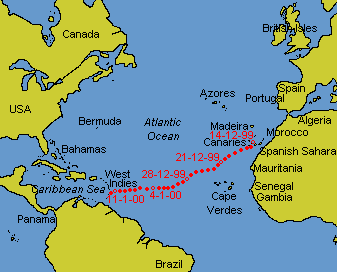
© Copyright 1999-2000 Nigel Jones/MistWeb Software

Due to the wonders of GPS satellite navigation, we knew well in advance that we would be closing the island of Barbados too early on the 12th January 2000. Barbados is not well lit on its windward and reef-strewn east coast. It is important, especially given the strength of the westerly wind and the associated ocean current, not to arrive in darkness. At 0730 on the 11th January we were able to check with George, KP2G, that the wind was not likely to drop in the next 24 hours. By 0840 I had rolled away half of our already small jib, set the electric self-steering up (the windvane was unable to cope with our reduced speed) and out ETA near the coast had become about 0600 on the 12th.
 | CHART |
 | |
| Sketch Maps and Chartlets (not to be used for navigation!) © Copyright 1999-2000 Nigel Jones/MistWeb Software | |
Bridgtown, its associated harbours and the anchorage are situated on the sheltered west coast of the island. Trudi, with her local knowledge and the benefit of feedback from hundreds of yachts whom she has talked into these waters, recommended that we approach the northern tip of the island and sail south down to the harbour. There was a little north in the easterly wind and her advice was to avoid the shallows off the south coast and take advantage of this wind.
At 2130 on the 11th January we were excited to see our first light from the island off our port bow. There was a tiny red speck visible (an aircraft warning light atop a radio mast on Mount Misery, the highest hill) and a distinct glow in the sky from the street-lights and habitation.
I had set the datum of the GPS receiver to 'North American Datum, 1927: Caribbean' in the hope that this would negate charting errors and make our satellite receiver and the British Admiralty charts of the island read true together. In order to make sure of this I also spent the night crossing our plotted satellite positions with hand-compass bearings on this light and with radar ranges to the rocky north-western coastline of the island. I had errors of a half to three-quarters of a mile most of the time, but this was acceptable given the vagaries of radar ranging and the distance to the light.
By first light, at 0626, we had reached a waypoint I had set three and a half miles off the island's North Point. Soon after 0700 we were discussing our landfall on the amateur radio with Trudi, 8P6QG, and Clive and Margot, M0COA/MM, who were anchored in Carlisle Bay. I was telling them that what I was really looking forward to was that first cold beer. The first stop in a bar or cafe ashore can be a great moment after a long sea-journey. Suddenly I had to leave the microphone and help Nicky close all the hatches as another nasty set of black squall-clouds blocked out the morning sun behind us. Rusalka Mist took it without complaining, as we slanted our course to the south and into the first sheltered water we had seen for a month.
The heavy rain soon passed and we were at last clear of the big Atlantic swells. The short chop kicked up by the squall was managing to slap up the side of the boat and find its way right through the main hatch, however, with all the insistence that the big wild ocean had had in the open sea!
The island looked very low to our eyes, after our long stay in mountainous Tenerife. The northern and western coastal regions we were looking at do not rise much above 50 m (150 ft) above the sea. What did strike us was that the island is fringed with the most tropical-looking vegetation: lofty coconut palms spring from the low-lying trees at every angle, frondy bushes dip right down to sweep the golden sand. We spent the morning tidying the boat inside and out as we tracked down the sheltered coast about a mile from the narrow sandy strand.
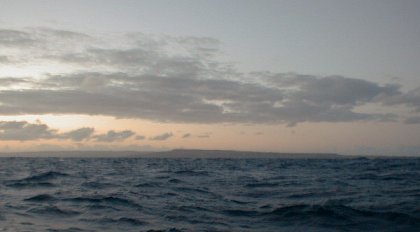 |
| As dawn broke on our last day ay sea, the island of Barbados was clearly visible on the horizon ahead. |
Unlike anywhere else we have have ever been, in Europe and the Canaries, it seems that the Caribbean islands have the most arcane, elaborate and strictly enforced checking-in and checking-out procedures for yachtsfolk. The first step was to respectfully ask permission to enter the Deep Water Harbour (the last place we wanted to enter, really!) on VHF channel 12. The controller told us that there wasn't really room for us in there, but that we were free to enter.
After spending best part of an hour playing dodgems with the tugs, freighters and charter boats around the entrance, we motored up the harbour to find a large Canadian sail-training vessel in the checking-in berth. I approached and asked if we could come alongside. A couple of jobsworths on deck said that the skipper was ashore and so no, we could not. I asked how long they were going to be in the berth and they said, "Oh, a couple of days," before turning their backs and going below to preclude any further discussion. I was all for tying up to them anyway, but Nicky did not want to begin our visit by antagonising anybody.
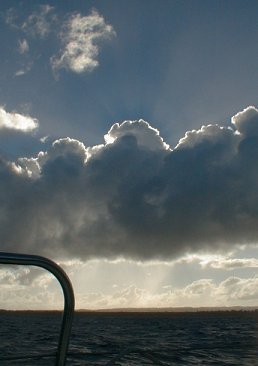 |
| One of our last squalls blots out the sun as we round Barbados' North Point |
Eventually we found a local charter catamaran who was willing to let us come alongside while Nicky jumped aboard to get ashore, although they were leaving immediately and we could not secure there. Nicky went with all our ship's papers, our passports and $100 in US currency to see if she could pass as skipper to check us in while I looked after the boat. This was at 1215 and it was to be an hour and a half before she emerged having visited separate Customs, Immigration and Health offices, handed over US$25 and had the rest changed into Barbados dollars for use ashore.
Meanwhile I had been motoring gently around the top of the harbour watching a small German yacht swing around unattended beneath the bowsprit of the sail-training square rigger. Eventually the single-hander appeared, untied and motored past me, calling, "A very lot of paperwork!" as he did so, pointing his thumb back at the quay.
I decided that if he could get in and out of there, so could I. It was the south-east corner of the harbour, defended on the right by the bowsprit above and on the left, at right angles, by an enormous cruise-liner. This sported both a great curving bow above and a bulbous underwater protrusion below me as I nosed into the wind toward the quayside. I got a couple of ropes secure with no problem, and began setting springs and fenders.
The problems were caused by a combination of two things. The solid rubber cylindrical fender strung along the wall on chain was too high. It would be quite useful to a much larger boat but came at Rusalka above her rail where it could bear only against our one-inch (25 mm) stanchions and lifelines. This would not have mattered if it were not for the fact that the wall itself did not come down to sea-level. Underneath was a hollow space filled with support girders and an indeterminate mass of surging water. As the water surged out around our hull and keel my lines were twanged to full tautness, but as it surged back in the stanchions took forces for which they and their mountings were not designed. I stuffed as many fenders as I could between the rail and this rubber buffer and then stood for the rest of the hour-and-a-half trying to hold her off (impossible) and re-position the fenders as they flipped out of place (dangerous).
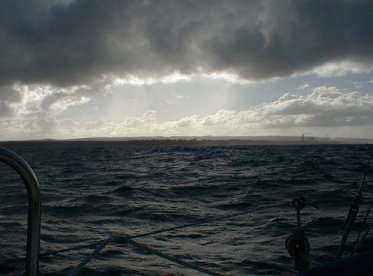 |
| As the squall covers us, you can pick out some of the detail of Barbados' low, tropical coast. |
I was struck by how friendly everybody was. I was spoken to by various Americans - both passengers and crew from the cruise ships - as well as by passing locals whether delivering mail or going about other dock-side business. I was made to feel more welcome than ever before in a strange port and twice got into detailed conversations about our crossing and the equipment on the boat.
When Nicky returned it took help from the strong hand of a passing Customs official to lower her down to our deck. Manoeuvring out of the berth was hair-raising. I motored hard astern while the head-wind swung our bow to starboard. We came within a foot (0.3 m) of hooking our forestay and the foil of our roller-reefing onto the end of the bowsprit. This was more by luck than judgement.
As we motored around the point from the Deep Water Harbour into the anchorage in Carlisle Bay, the skyline of Bridgetown came into full view. Whereas we had been struck by the paint-peeling concrete tower-blocks and tatty sky-high advertising boards of Santa Cruz from the sea, here the view was entirely different. Almost no building is over two stories high, many show slightly rusty corrugated iron roofs and, due to the low-lying land, a waterfront of warehouses, ancient and modern, almost completely hides whatever may lie behind. It is hard to believe that you are looking at the main capital of a proud little nation. The waterfront a little further along the bay is leafy and green with trees dividing the main road, its bars and its car-parks from the sand.
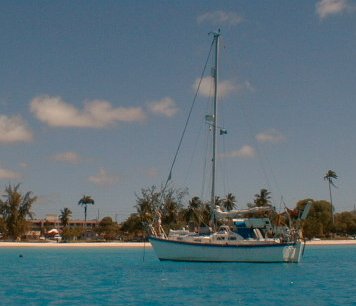 |
| Finally, Rusalka Mist is safely anchored in Carlisle Bay. |
There were perhaps two dozen yachts, a couple of small commercial ships and maybe another dozen local open fishing boats anchored along the bay.
We quickly found Revid, Margot and Clive's boat, among them and motored past to say hello before dropping our anchor just ahead of them, a little closer to the beach. Within a minute the pair of them were in their dinghy and rowing over to us. In the carrier bag that was the first to come aboard was my wish of the morning unexpectedly come true: four ice-cold beers from their refrigerator. It was wonderful.
As we swigged from our bottles they told us about our plans for the next day: we were invited for lunch to meet Trudi, her husband Ian and son Martin at their home the other side of the island. Clive and Margot would take us ashore in their dinghy and we would travel by bus to the house. All we had to do now was to get a good sleep.
Within half an hour they were gone, we re-anchored into a better spot slightly nearer the beach, and we were both soon asleep.
I slept the clock around without moving a muscle. I eventually woke myself up by trying to move my leg: the pain in my knee which awoke me turned out to be echoed by every joint in my body. After the wear and tear of 'holding on tight' for so long as the boat dipped and bucked, followed by sleeping so soundly that I did not move for twelve hours, every joint had seized up. It took a day or so before the aches and pains died down.
Maybe a bit like banging your head against the wall, sometimes the best thing about sailing is... when you finally stop!
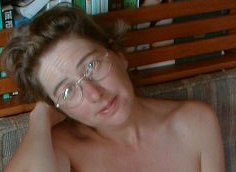 |
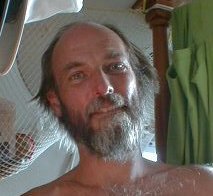 |
| After a first good night's sleep, both of us greeted the next day with a mixed feeling of happiness, relief and more than a little amazement at what we had just achieved. After a good shower in the morning, and with our hair clean again for the first time in a month, we began to take it all in. | |